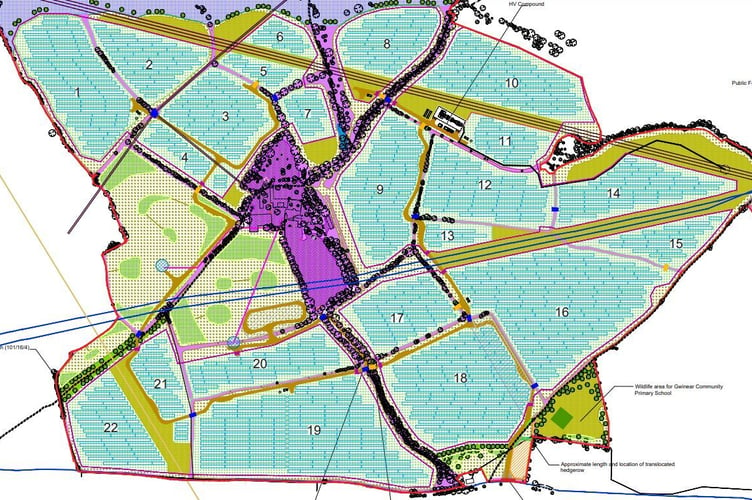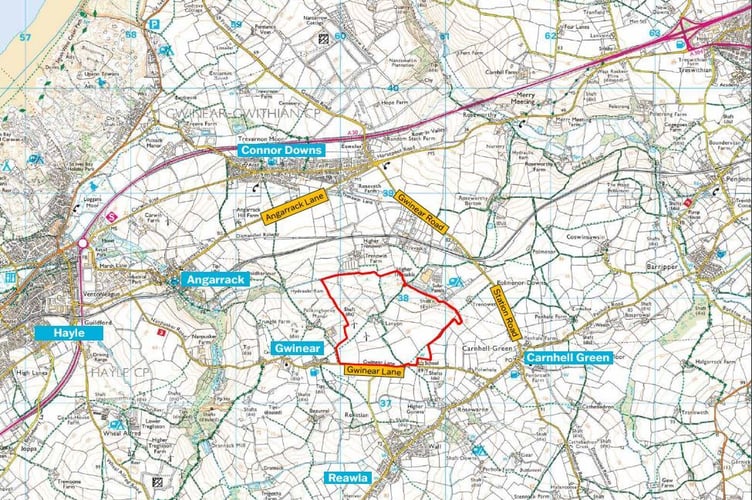Almost 100 residents and three neighbouring town and parish councils are strongly opposed to proposals to build a huge solar farm on almost 200 acres of land – 22 fields – near a Cornish village.
They fear the installation of thousands of glass panels will kill off farming in the area.
Speedwell Solar Farm Ltd – owned by Statkraft, Europe’s largest generator of renewable energy – has applied for planning permission for a 40MW solar farm, together with associated works, on 77.1 hectares (190.5 acres) of agricultural land at Lanyon Farm north of Gwinear, near Hayle. The development would be operational for 40 years and have the potential to power the equivalent of 12,000 homes.
The development would sit about 300 metres south of the Hayle-Camborne railway line, near popular farm shop and restaurant Trevaskis Farm, Riviera Produce and Higher Trevaskis Caravan and Camping Park.
Siting huge solar farms on productive agricultural land has become such a hot potato in Cornwall that the local authority agreed last year to commission research to explore the economic role of “best and most versatile” Grade 3 land. Councillors want to ensure that planning decisions take into account the right balance between use of land for food production and renewable energy.

The Gwinear plan is the latest of several large-scale solar farm applications called before a Cornwall Council planning committee due to concerns raised by locals. In November the 210-acre Fairpark solar farm proposal in the Hendra valley, near Mitchell, was refused, with its effect on valuable farming land being cited as one of the reasons.
The Speedwell application – which also includes a 50-space car park and wildlife area for Gwinear Community Primary School – has been recommended for approval. However, it has been brought before a strategic planning committee next week (Thursday, February 13) by local councillor Lionel Pascoe owing to the loss of nearly 50 per cent Grade 3a agricultural land, harm to the setting of a Grade II listed farmhouse, potential flooding to nearby Angarrack village and highway access concerns.
A report to the planning committee outlines recent government changes to National Planning Policy Framework to support renewable energy provision, but with less restrictions.
It states: “However, just under half of the application site comprises best and most versatile agricultural land, the proposed development would industrialise the setting of the Grade II listed Lanyon Farmhouse which contributes to its significance and the proposal would give rise to some landscape harm, owing to its large scale and rural setting.”
A planning officer said there were several mitigating factors including “the land not being the highest grade of agricultural land with the potential for continued agricultural activity at the site”. It was also highlighted that the development would be temporary and fully reversible.
“In this case, it is considered that the benefits of the proposed development in terms of significant renewable energy provision during a climate emergency (which should not be understated) outweighs the harm caused,” adds the report.
However, a large number of people disagree with the planning department’s assessment. Almost 100 people have objected to the proposal on Cornwall Council’s planning portal, with the majority sharing concerns about the possible loss of valuable agricultural land.

Philip Laity wrote: “Being a fifth generation farmer on two sides of the proposed development, I have come to know the value of this land in terms of food production. The use of Grade 3 land which can be double cropped should be utilised for its best use: feeding our ever-growing population.
“Farming land in five parishes across mid and west Cornwall, the land in the parish of Gwinear is without doubt the best and most versatile of all. It is not without coincidence that two major produce growers have their packhouses situated within very close proximity, being in the heart of their most productive land.”
Giles Eustice, owner of Trevaskis Farm and brother of former Tory MP George, added: “If we approve solar farms at this scale on our farming land, we will devastate our local economy. It brings nothing of value for our communities.
“As a business on the opposite side of the valley to this proposal, we employ over 130 people and put in excess of £1.5-million of wages directly into the local economy through that employment. At no point have we been considered and no assessment has been carried out on the impact it may have on our business.”
Gwinear-Gwithian Parish Council has objected on a number of grounds, including loss of agricultural and food production land, landscape sensitivity and scale of development.
Hayle Town Council – which is based half a mile away from the site and has a “strong objection” – added: “This best and most versatile agricultural land needs to used for food, not electricity. Electricity can be generated elsewhere and in other ways – roofs, windfarms, etc.
“The town council is extremely conscious of the socio-economic factors that the loss of this farmland would have. It would not only impact on the farming families directly but also on their employees, contractors and a whole host of local goods and service trades.”
The parish council of St Erth, which is less than two miles away from the site, also objects. A spokesperson said: “The land proposed for this solar farm is on Grade 3 best and most versatile land that can be double cropped, which is contrary to Cornwall Council’s policies and should be safeguarded for food production not electricity.”
The Lead Local Flood Authority (LLFA) originally objected to the application but has since withdrawn its concerns following discussions with the applicant and their consultant, with the suggestion of conditions if approved.
A previous application for a smaller solar farm on a different footprint of the site was made by Good Energy Limited in 2013. Councillors went against officer recommendation to approve due to concerns about the loss of the Grade 3a land.
The refusal was appealed by the applicant, which was subsequently allowed. That decision was then quashed by order of the High Court in 2015. The applicant later withdrew their plans.
The new proposal is one of two solar farm applications in the Hayle area to be decided by a strategic planning committee next Thursday.





Comments
This article has no comments yet. Be the first to leave a comment.